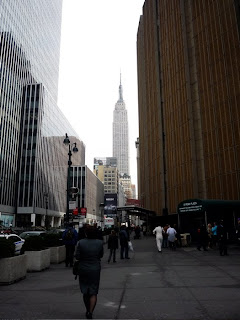I Choose Flâneuse: A Tale in Four Parts, with each part increasingly shorter
I. PART ONE.
Over the course of the past several weeks, while strolling the avenues of New York City, stopping to gaze at this thing and that, I have contemplated the relationship of this publication to the rich heritage of the flâneur, or in my case, the flâneuse. Associated with the strolling aristocrats of the Parisian Belle Epoque and the poet Charles Baudelaire in particular, the flâneur tradition came to prominence in literary circles as a trope of modernity. (I went to graduate school.) Virginia Woolf, with Mrs. Dalloway, and James Joyce, with Ulysses, are often cited as authoritative on this subject. Influential critic Walter Benjamin meditated deeply on the flâneur. 
From The Arcades Project,
The crowd is the veil through which the familiar city beckons to the flâneur as phantasmagoria–now a landscape, now a room. Both become elements of the department store, which makes use of flânerie itself to sell goods.
And then he starts talking about The Communist Manifesto.
A dear college friend called me a "flâneurette" last week, a name that made me giggle like a school girl, because it sounds like a combination of a flâneuse and a Kilgore College Rangerette. I imagined a "flâneurette" marching down Fifth Avenue in cowgirl boots and twirling a baton. I see this every day in New York. But since I can't hold a smile for that long, I choose flâneuse to describe myself. It's proper, and though I take liberties with my own language, I don't mess with the French.
Strolling this rich avenue of flânerie, I have taken to my study late at night, the one hidden behind the secret door, to read further upon the subject. There, by gaslight and a flickering flame, I read matters mystical, hysterical, prophetical and prosaic on the tradition of flânerie. I search for the American counterparts of the tradition. Poe is certainly known, but we can add Henry James and Edith Wharton when they're not riding carriages. In fact, most all fictional characters before the twentieth century had to walk at least part of the time as they had no car. The spouse, a colonel and a film fan, handed me a book on the subject in Weimar culture. Book recommendations will come in due course.
It was during such an evening in my study, deep into a moonless Gotham night, that I came across the existence of a publication so startling, so full of genius, that I could scarce believe my very eyes. Produced by a brotherhood of fellow flâneurs, their publication must serve us as the starting point (and all that's in the middle) for what is known on the subject. Excitedly I dashed off a note of introduction. Nervously hitting the send button, for that is how we communicate in our era, I didn't even dream of a reply.
Oh, readers!
to be continued.....

From The Arcades Project,
The crowd is the veil through which the familiar city beckons to the flâneur as phantasmagoria–now a landscape, now a room. Both become elements of the department store, which makes use of flânerie itself to sell goods.
And then he starts talking about The Communist Manifesto.
A dear college friend called me a "flâneurette" last week, a name that made me giggle like a school girl, because it sounds like a combination of a flâneuse and a Kilgore College Rangerette. I imagined a "flâneurette" marching down Fifth Avenue in cowgirl boots and twirling a baton. I see this every day in New York. But since I can't hold a smile for that long, I choose flâneuse to describe myself. It's proper, and though I take liberties with my own language, I don't mess with the French.
Strolling this rich avenue of flânerie, I have taken to my study late at night, the one hidden behind the secret door, to read further upon the subject. There, by gaslight and a flickering flame, I read matters mystical, hysterical, prophetical and prosaic on the tradition of flânerie. I search for the American counterparts of the tradition. Poe is certainly known, but we can add Henry James and Edith Wharton when they're not riding carriages. In fact, most all fictional characters before the twentieth century had to walk at least part of the time as they had no car. The spouse, a colonel and a film fan, handed me a book on the subject in Weimar culture. Book recommendations will come in due course.
It was during such an evening in my study, deep into a moonless Gotham night, that I came across the existence of a publication so startling, so full of genius, that I could scarce believe my very eyes. Produced by a brotherhood of fellow flâneurs, their publication must serve us as the starting point (and all that's in the middle) for what is known on the subject. Excitedly I dashed off a note of introduction. Nervously hitting the send button, for that is how we communicate in our era, I didn't even dream of a reply.
Oh, readers!
to be continued.....





Comments
Post a Comment